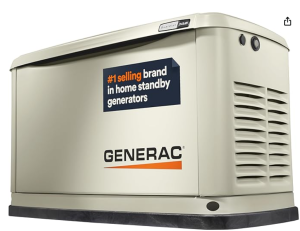When the power goes out, everything from your lights to your fridge to your HVAC system can shut down. A typical outage might last minutes, hours, or longer — and in cold climates or remote areas, it can quickly become a major problem. A whole-home standby generator automatically kicks in when utility power fails, keeping your home running seamlessly.
In this guide you’ll learn how to choose the right size, fuel type, transfer equipment, installation considerations, ongoing maintenance, and mistakes to avoid — so you buy once and get it right from the start.
How To Size Your Generator Correctly
Start With Your Intent: Full Home vs Essentials
The first question is simple: do you want to power everything like normal, or just the essentials during an outage? That single choice drives your generator size, the transfer gear you’ll need, and ultimately your budget.
Nameplate kW is Just a Starting Point
A nameplate spec (for example “22 kW” or “24 kW”) tells you maximum continuous power output — but it doesn’t tell the whole story. Two homes of the same square footage can have wildly different electrical profiles. For example:
- A large house with two central air-conditioning units, a well pump, electric range, and multiple freezers has far higher starting (surge) load demands compared to a smaller house with mostly gas appliances.
- The key figure to respect is the starting or surge load, especially from motors and compressors (AC units, water pumps, etc).
- A simple approach: list your must-run circuits, note their running watts, and flag anything with a motor or compressor for higher start amps. Then talk to your installer about a load calculation and the possibility of soft-start kits on air conditioners, which reduce surge and often let you use a smaller, quieter generator.
Fuel Choice & Available Output
Propane vs Natural Gas
Most residential standby generators are rated higher on propane (LP) than on natural gas (NG). It’s common to see something like: “X kW on LP, and about 10-15% less on NG.”
Make sure your gas meter and regulator can supply the required BTU/hr at full load with correct line size and pressure. An undersized gas line or regulator is a frequent cause of poor generator performance during utility failure.
Transfer Switch & Smart Load Management
The automatic transfer switch (ATS) senses utility power loss, starts the generator, and transfers the load — then switches back and allows the generator to cool down when grid power returns.
Pairing the ATS with load-shedding modules or a smart load-management controller helps prioritise essentials (lights, fridge, furnace) and temporarily delay big loads (EV charger, pool pump, dryer). This means you don’t need to oversize your generator just to survive a rare one-second spike.
22 kW vs 24-26 kW: Which One Do You Need?
In many homes a well-planned ~22 kW unit (with soft-starts and smart load management) can run the whole house comfortably.
But if you have multiple large ACs, an electric range or dryer, a well pump, EV charger — or you simply want fewer compromises during an outage — stepping up to the mid-20 kW range may make sense.
Avoid paying for capacity you barely use, but also avoid undersizing and forcing constant load shedding. Aim for balance with a little headroom.
Noise, Placement & Installation Considerations
Modern standby generators are quieter than most lawn equipment during their weekly exercise cycle — however placement still matters:
- Follow clearance rules from doors, windows and property lines.
- Elevate the unit in snow- or flood-prone areas.
- Point exhaust away from bedrooms.
- Think about how walls or fences reflect sound — a small relocation or wall bracket can noticeably reduce what you hear indoors.
- Mount the generator on a level, stable pad. Pre-cast composite pads are OK, but a poured slab offers superior durability. Plan gas and electrical routes before installation — short, well-sized lines and tidy conduit mean fewer problems later.
Cost Drivers: What Affects Price?
Several major factors influence cost:
- Generator size (kW output)
- Type of ATS/transfer switch
- Gas upgrades (meter/regulator/pipe length)
- Trenching and permits
- Pad/foundation
- Load-management modules or soft-start kits
Paying for professional design and installation is worth it — most reliability issues stem from undersized gas supply, poor wiring practices or sloppy commissioning.
Maintenance: Keep It Ready
Keeping the unit ready is straightforward: plan periodic oil and filter changes, battery checks, air filter and spark plug replacement, and a weekly exercise cycle. App-based monitoring helps you track run hours, system status and fault codes. Whether you DIY or choose a service plan, the goal is simple: no surprises during an outage.
Brand vs Installer: What Really Matters?
Brand choice matters less than people think. Top manufacturers can all deliver when the system is designed and installed correctly. What matters most is a reputable installer who sizes loads properly, verifies fuel-supply/gas pressure, pressure-tests, configures load-management settings, and documents the job. Clean workmanship today equals fewer callbacks tomorrow.
Common Mistakes to Avoid
- Oversizing without a plan.
- Undersizing and skipping load management.
- Ignoring fuel-supply limits.
- Placing the unit near windows/openings or in snow-drift zones.
- Postponing maintenance until the storm hits.
- Forgetting soft-start kits for ACs — one of the easiest wins you can buy.
Decision Framework: Fast Checklist
- List your critical loads (lights, fridge, HVAC, pumps).
- Confirm fuel supply capacity & pressure.
- Decide whether you want full-home “normal” operation or essentials-only.
- Choose an ATS + smart load-management system.
- Consider soft-start kits for major motors (ACs, pumps).
- Pick the smallest generator that runs your plan comfortably with a bit of headroom.
Top-Rated Generators

Generac Guardian 22kW Home Standby Generator
Generac Guardian 24kW Home Standby Generator
Final Thoughts
A standby generator is an investment in peace-of-mind. It’s not just about watts and dollars — it’s about real-world outcomes when your utility power fails. Take the time now to get the size, fuel, setup and installer right. With the right planning you’ll avoid frustration, buy once and sleep soundly — no surprises when the lights go out.
